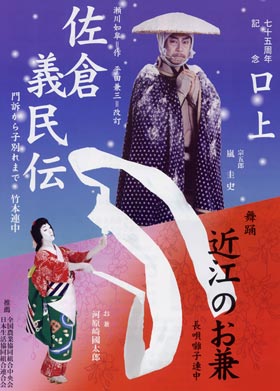| JULY 2006 |
|
3 shows in T˘ky˘ (Kabukiza, National Theatre), 2 in ďsaka (Sh˘chikuza) and 3 tours (Eastern Provinces, Central Provinces, Zenshinza)!
|
| Kabukiza (T˘ky˘) |  |
| Dates | 7 ~ 31 July 2006 (Shichigatsu ďkabuki) |
| MatinÚe |
Yasha-ga-Ike Kaijin Bess˘ |
| Evening |
Yamabuki |
| Casting |
Band˘ Tamasabur˘, Ichikawa Ebiz˘, Ichikawa Danjir˘, Ichikawa Ukon, Ichikawa Emisabur˘, Ichikawa Monnosuke, Ichikawa En'ya, Ichikawa Shun'en, Nakamura Karoku, Band˘ Shinsha |
| Comments |
A great summer program, which celebrates the playwright Izumi Ky˘ka (1873~1939), with 3 of his most famous dramas, "Yasha-ga-Ike", "Kaijin Bess˘" and "Tenshu Monogatari". All of them are depicting fantastic worlds of demonic gods, princesses, handsome warriors under the sea, on top of a castle tower or at the bottom of a cold mountain lake:
|
| Sh˘chikuza (ďsaka) |
| Dates | 2 ~ 26 July 2006 (Shichigatsu ďkabuki) |
| MatinÚe |
Shinshű Kawanakajima Kassen (Terutora Haizen)
|
| Evening | |
| Casting |
Sakata T˘jűr˘, Kataoka Nizaemon, Onoe Kikugor˘, Nakamura Tokiz˘, Nakamura Jakuemon, Kataoka Gat˘, Kataoka Hidetar˘, Nakamura Kanjaku, Kataoka Takatar˘, Ichikawa Danshir˘, Band˘ Takesabur˘, Ichikawa Danz˘, Kataoka Ainosuke, Kawarasaki Gonjűr˘, Ichikawa Unosuke, ďtani Tomoemon, Ichimura Kakitsu, Kataoka Shinnosuke, Nakamura Kazutar˘ |
| Comments |
Sakata T˘jűr˘ celebrates his shűmei in ďsaka, playing the roles of Danshichi Kurobŕ and the shiraby˘shi Hanako in the drama "Natsu Matsuri" and the dance "Musume D˘j˘ji".
|
| National Theatre (T˘ky˘) |
| Dates | 3 ~ 24 July 2006 (Shichigatsu Kabuki Kansh˘ Ky˘shitsu) |
| Program | |
| Casting |
Nakamura Baigyoku, Nakamura Shibajaku, Nakamura Matsue, Nakamura Utae |
| Comments |
Educational program at the National Theatre called Kabuki Kansh˘ Ky˘shitu ("Kabuki Appreciation Class"). This is a very interesting formula for the beginners because there is lively presentation of Kabuki (or some aspects of the art like music, stage tricks or fighting scenes) on stage, followed by the drama "Keya-mura": Rokusuke (Nakamura Baigyoku), a sword master who lives a simple country life, is taking care of a small foundling child. He hangs the boy's kimono outside his house in the hope that the boy's relatives will see it and know where he is. One day he finds himself attacked by a woman named Osono (Nakamura Shibajaku) who turns out to be the aunt of the child. As they talk, they find that they are in fact linked by promises of marriage although they have never met directly. Osono is searching for the killer of her father, Rokusuke's master, and Rokusuke promises to help in her vendetta. |
| Kabuki Tour in the Central Provinces | |
| Dates | 30 June ~ 31 July 2006 |
| Program | |
| Casting |
Matsumoto K˘shir˘, Ichikawa Komaz˘, Ichikawa Somegor˘, Sawamura S˘nosuke, Matsumoto Kingo, Band˘ Kamesabur˘, Band˘ Kametoshi |
| Comments |
"Kanjinch˘" is probably the most popular Kabuki play today, it includes dance, comedy and the heart-warming pathos of a band of heroes during their last days. Disguised as a band of traveling priests the fugitive general Yoshitsune and his small band of retainers are stopped at a road barrier. They escape only through the quick thinking of the head retainer, a warrior priest named Musashib˘ Benkei, who improvises the text of an elaborate imperial decree. Having escaped danger Benkei and the others describe their days of glory and hardships on the road to escape in a moving dance. This program stars Matsumoto K˘shir˘ in the role of Benkei (his best atariyaku), with Ichikawa Komaz˘ and Ichikawa Somegor˘ as Yoshitsune and the barrier keeper Togashi. |
| Kabuki Tour in the Eastern Provinces | |
| Dates | 30 June ~ 31 July 2006 |
| MatinÚe | |
| Evening |
|
| Casting |
Nakamura Kanzabur˘, Nakamura Senjaku, Nakamura Genzaemon, Kataoka Ichiz˘, Kataoka Kamez˘, Band˘ Yajűr˘, Nakamura Shinobu, Nakamura Shichinosuke, Band˘ Shingo |
| Comments |
Nakamura Kanzabur˘ celebrates his shűmei in the Eastern provinces, playing the roles of Uky˘ and Gonta in "Migawari Zazen" and "Yoshitsune Senbon Zakura".
|
| Zenshinza Tour | |
| Dates | 1 ~ 31 July 2006 |
| Program | |
| Casting |
Arashi Keishi, Kawarasaki Kunitar˘, Segawa Kikunoj˘, Fujikawa Yanosuke, Yamazaki Ryűnosuke, Yamazaki Tatsusabur˘, Osagawa Genjir˘, Anegawa Shinnosuke, Kiriyama Rish˘ |
| Comments |
|
 |
|
|
|
| Contact | Main | Top | Updates | Actors | Plays | Playwrights | Programs | Links | FAQ | Glossary | Chronology | Illustrations | Prints | Characters | Derivatives | Theaters | Coming soon | News |